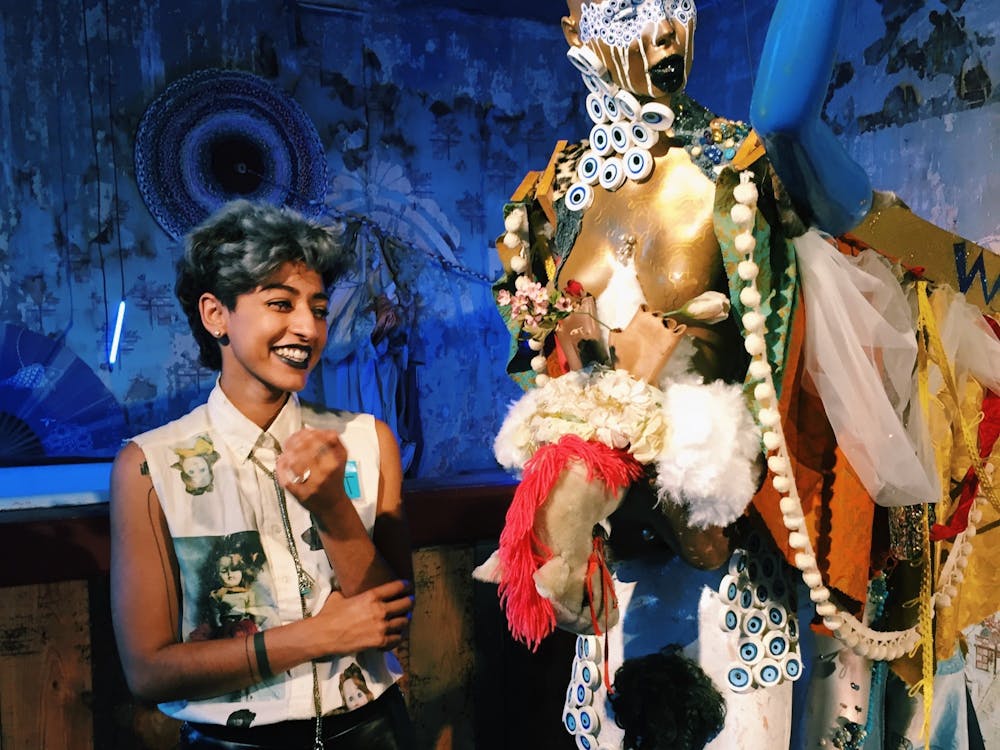“Many of our stories are couched in trauma, which is a truth that's necessary to tell,” Taj said. “But it's not the only one, and I think it impacts us when those are the ways that we see ourselves represented. So, in thinking about how to create a more comprehensive vocabulary, I think it's important to offer some alternatives there.”
Community and activism
Antoine Williams, an associate professor for art at Guilford College, was introduced to Taj’s work at one of their solo exhibitions at The Carrack, a community art space in Durham. Taj served as executive director of the art gallery from summer 2018 to summer 2019.
Williams and Taj have also worked together through artist talks at Guilford College, such as the “Art and Identity Discussion Series.” During the series, artists from underrepresented communities spoke about their work.
“Their work is so layered, it's so interesting,” Williams said. “It's aesthetically really interesting, conceptually as well. And the way they interact with people, the way they talk about their work is really intriguing.”
Williams said that he likes to surround himself with people whose work pushes him, like Taj.
“I try to surround myself with artists like that — who are always sort of pushing the envelope,” Williams said. “You see them every few months do something that's really really interesting and that sort of keeps me motivated and engaged as well. (Taj is) one of those ones I tend to keep close.”
Taj is also involved in community activism, and in the past, has offered their art in service through graphics and banners for organizations like Southerners on New Ground, Durham Artists Movement, National Domestic Worker's Alliance and Muslims for Social Justice.
Currently, Taj is a member of Durham Beyond Policing, a grassroots coalition dedicated to divesting resources from prisons and police forces and investing in Black and brown communities’ health and wellbeing.
Taj said their individual art practice can be political, but it is distinct from their activist work.
“I think that the community-based element of (activism) is critical,” Taj said. “That it's not just about my singular voice as an artist, which is important, but also how are we pushing for a lot of other voices to be included? How are we making connections with folks who are most deeply impacted by the issues that are most urgent in our cities? And I think that that local focus as well is another important piece of (activism).”
A personal timeline
To get the day's news and headlines in your inbox each morning, sign up for our email newsletters.
For Taj, their artwork has been almost like a “personal timeline,” they said, helping them grapple with different topics, such as the pressure they have felt within and outside of Muslim communities.
“I just feel like there was a real deep pressure for conformity,” Taj said. “And, at different moments, it was literally like, ‘You have to represent all Muslims.’ Those words have been spoken to me. And that is heavy because what that means in a place that is, you know, decidedly Islamophobic, requires a level of respectability and perfection. That is dehumanizing and impossible, as well.”
Taj cited Technicolor Muslimah — an early work from 2011 that centered on representing Muslim women in a counternarrative to stereotypical images in media — as significant in emphasizing parts of their Muslim heritage through connecting with people from their life that Taj was previously distanced from.
“I am Muslim because these are my people,” Taj said. “And I'm Muslim because that's part of my language, part of my history, part of the allegories that show up in the work.”
After producing that series, Taj said they’ve gone on to explore ways to present and articulate their Muslim background in other pieces.
“And through that practice, it's really this way of claiming Islam, not just in this one flat sporadic form that was presented to me on a lot of different ways, but as something that is alive and transforming through the people who practice it,” Taj said.
By incorporating their identities into their art, through the subject matter and the stories they choose, Taj said other people who share similar identities can see themselves in their work.
For students like Modi, the presence that Taj brings into the classroom as a lecturer has been especially memorable.
“It's been such a joy learning from them,” Modi said. “I think it's typical to see white people in these spaces, especially in academia and art, and so getting to learn from someone who comes with a very different perspective has been really really insightful and inspiring, too.”
university@dailytarheel.com | elevate@dailytarheel.com



